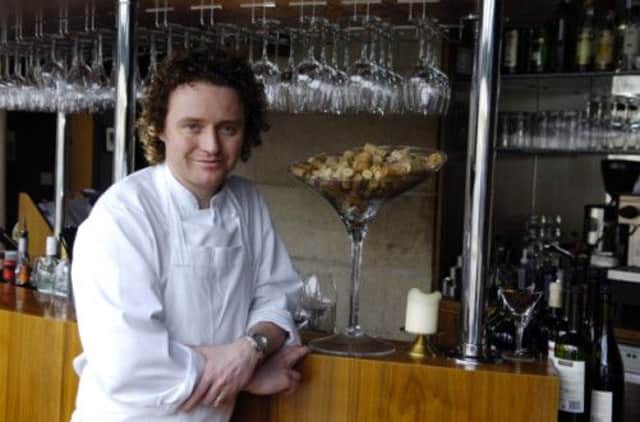Tom Kitchin: Meat from wild duck is outstanding


If you’re trying wild duck, you may also come across teal and widgeon. These are smaller but equally delicious. You can usually serve one mallard between two, but when it comes to teal, one bird per person is a perfect portion.
The first step to cooking mallard is finding top-quality game bang in season and as fresh as can be. As is the case with all meat, duck should be bought from a source you trust – a good butcher, farmers’ market or shop. There are lots of quality online suppliers these days too. Whichever breed, type or cut you choose, look for those with clear, soft skin, without bruising, blemishing or tears.
Advertisement
Hide AdAdvertisement
Hide AdGenerally, wild duck has less fat than a lot of other meats so you need to take greater care when cooking. However, oven roasting the duck, you will find a fair amount of fat will collect under the bird so you tend not to really need to add any fat when you’re cooking. It can be all too easy to overcook, and they can dry quite quickly, so make sure you keep checking, especially if you’re trying it for the first time.
Mallard is best if you roast it whole, as you really do get varying flavours from all of the different parts of the bird. Sometimes they will require different cooking techniques for the best results, but don’t be afraid to try cooking and eating it all. The breast is wonderful roasted, grilled or sautéed, while legs are delicious if you braise or confit them, and are also a great addition to stews and casseroles. If you’re sharing the bird between two people, make sure you each get to try a bit of breast and a leg because the most joyful part of eating the whole bird is experiencing all the unique flavours.
Meat from wild duck is outstanding – it’s deeply rich and full of flavour but you need something quite sharp or fruity as a natural match to really cut through that richness. I like to serve mallard with some vibrant red cabbage and watercress, but it works just as well with celeriac, turnip and beetroot which are all at their seasonal best at the moment.
Duck is also often paired with sharp, fruity flavours like apples, blueberries and raspberries, which can all be found around the bird’s natural habitat. If you can master the roasting of the mallard, you can enjoy experimenting with different seasonal accompaniments.
Roast mallard with gnocchi
Serves two
1 large mallard, cleaned
vegetable oil
200g girolles
4 flat leaf parsley leaves
1 sprig thyme
1 tbsp chopped chives
1 shallot, finely chopped
1 garlic clove, finely sliced
1 apple, cored and cut into wedges
200g potato gnocchi
8 Brussels sprouts, blanched and halved
1 handful watercress
salt and pepper
To roast the mallard
Follow the instructions in the red cabbage recipe (right).
To cook the girolles
Heat a frying pan and add the vegetable oil, then add the girolles and cook until golden. Add the parsley, thyme, chives, shallots and finely sliced garlic clove. Season with salt and pepper to taste.
To serve
While the duck is resting, in a heavy-bottomed frying pan, sauté the apple in a teaspoon of oil, then add the cooked girolles and gnocchi. Season, add the Brussels sprouts, the watercress and cook everything together for a couple of minutes.
Place the duck on a serving dish with the vegetables around it and carve at the table for that extra wow factor.
Roast mallard with red cabbage salad
Serves two
1 large mallard, cleaned (ask your butcher)
vegetable oil
For the red cabbage salad
¼ red cabbage
½ tsp Maldon salt
150ml red wine
100ml malt vinegar
100ml white wine vinegar
100ml balsamic vinegar
½ tsp caster sugar
2 star anise
1 bay leaf
2 whole cloves
½ tsp black peppercorns
½ tsp pink peppercorns
1 cinnamon stick
½ tsp chilli flakes
¼ orange skin
1 apple, cored and cut into very thin matchsticks
To roast the mallard
Preheat the oven to 240C/gas mark 9. Pat the duck dry with kitchen towel and remove the wishbone, which makes it easier to carve once cooked. To do this, cut down either side of the bone with a sharp knife so you can get your fingers in, then pull and the bone will come away.
Advertisement
Hide AdAdvertisement
Hide AdSeason with salt and pepper and don’t forget to season inside the cavity.
Heat some oil in an ovenproof pan and brown the duck on both sides for two to three minutes. Place the duck in the oven and cook for 14 to 16 minutes, depending on its size. Remove from the oven and leave to rest for five minutes, then serve with your red cabbage.
To make the red cabbage
Cut the cabbage in half, remove the core and the outer leaves, then shred finely. Place in a colander, mix with the Maldon salt and leave for three hours, mixing regularly, then rinse, spin with a salad spinner and pat dry on a cloth.
Bring all the liquid and sugar to the boil, and reduce by half.
Blitz all of the spices and orange peel in a blender, then wrap in a muslin cloth.
When infused, pour the hot marinade over the cabbage and leave to cool.
Drain the cooking liquor and set aside. Then add a little olive oil to the cabbage before serving with the apple matchsticks as a garnish. You can use the cooking liquor as a lovely sauce for your mallard.